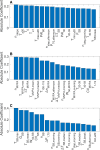Analysing physical activity measures and clustering in patients with type 2 diabetes in secondary care: insights from the DIAbetes and LifEstyle Cohort Twente (DIALECT)-an observational cohort study
- PMID: 39627150
- PMCID: PMC11624807
- DOI: 10.1136/bmjopen-2023-082059
Analysing physical activity measures and clustering in patients with type 2 diabetes in secondary care: insights from the DIAbetes and LifEstyle Cohort Twente (DIALECT)-an observational cohort study
Abstract
Objectives: To analyse variance in accelerometer-based physical activity (PA) measures in patients with type 2 diabetes, identify the most distinctive PA measures and classify patients into different PA clusters based on these measures.
Design: DIAbetes and LifEstyle Cohort Twente (DIALECT), an observational cohort study.
Setting: Secondary care in the Netherlands.
Participant: 253 patients, with three excluded due to insufficient data. The cohort was predominantly male (66%) with an average age of 64.7 years.
Primary and secondary outcome measures: The primary outcomes of DIALECT were all-cause mortality, microvascular and macrovascular diseases. The secondary outcomes are blood pressure levels, kidney function indicators and albuminuria levels RESULTS: Principal component analysis (PCA) was applied to 53 accelerometer-derived PA measures. Principal components were identified using a scree plot, key measures determining the principal components were derived and k-mean cluster analysis was applied to the components. The main PA measures were steps/day, active time, zero steps, total sedentary behaviour (SB) bout duration and total moderate to vigorous physical activity (MVPA) bout duration. Based on three PCA components, three clusters were identified. The inactive cluster had a higher BMI, diabetes duration, age and SB bout duration, and lower steps/day and MVPA bout duration compared with the other clusters (p<0.05). The active cluster still scores low on MVPA bout duration (18 min/week) and high on SB bout duration (5.0 hours/day).
Conclusions: PA behaviour in patients can be categorised into three distinct clusters. The identified PA measures and behaviour clusters offer promising opportunities for tailored lifestyle treatment. However, further studies are needed to determine which PA measures are clinically most relevant, validate the usefulness of this classification and evaluate whether tailoring lifestyle advice according to these clusters adds clinical value.
Trial registration number: NTR5855.
Keywords: Clinical Decision-Making; General diabetes; Information technology; eHealth.
© Author(s) (or their employer(s)) 2024. Re-use permitted under CC BY-NC. No commercial re-use. See rights and permissions. Published by BMJ.
Conflict of interest statement
Competing interests: None declared.
Figures



References
Publication types
MeSH terms
LinkOut - more resources
Full Text Sources
Medical
